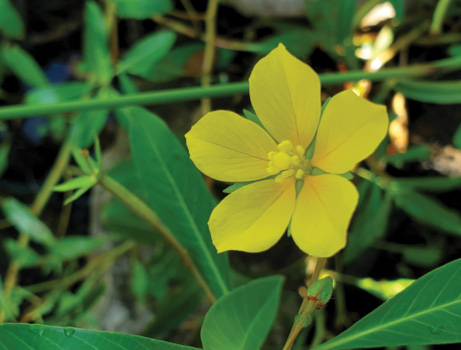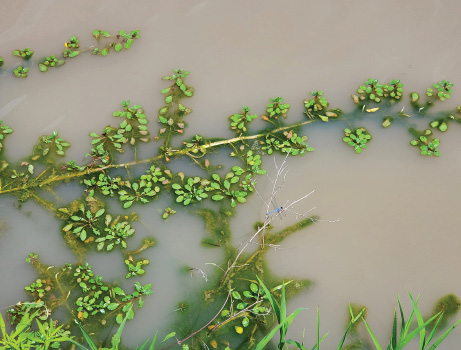Water Primrose | Ludwigia spp.
Emergent | Native


and characteristic yellow flower.

that extend from shore.
Water primrose is very common in Mississippi and has many species. It grows on the shore or in very shallow water. Over time, it will form a floating mat that is rooted near shore but may stretch out into more open water.
This species has alternating leaves that are arranged in a rosette at the stem tip. Leaves are covered on both sides by small, soft hairs.
Leaves of immature plants are typically oval and on the water surface, while mature leaves become more lance-shaped and emergent. Immature leaves are small, while mature leave can be 5 inches in length.
Stems are usually reddish and may be covered in long hairs. Subsurface stems have a spongy feel. Primrose foliage and growth form can be mistaken for the invasive plant alligator weed; however, alligator weed stems are hollow, while primrose stems are solid.
The flowers (Ranunculus repens) are bright yellow and resemble a terrestrial buttercup. Flowers may be present the entire growing season and have four or five petals.
Management Value
Water primrose is a food source for many animals. Waterfowl eat the seeds, and several insects consume the leaves. The plants provide habitat for juvenile fish and ambush locations for predators.
However, planting this species is not recommended because it can become problematic. Further, water primrose is very common and will usually establish naturally. In moderation it is not a problem, but it should be treated if it interferes with other water uses.
Recommended Controls
Option 1: Glyphosate (5.4-pound formulation). To each gallon of water, add 0.75 ounce glyphosate and 1.3 ounces non-ionic surfactant. Spray to wet all plants.
Option 2: Flumioxazin (4.0-pound formulation). To each gallon of water, add 0.05 ounce flumioxazin and 1.3 ounces non-ionic surfactant. Spray to wet all plants.
Option 3: 2,4-D (3.8-pound formulation). To each gallon of water, add 1.0 ounce 2,4-D and 1.3 ounces non-ionic surfactant. Spray to wet all plants.
Option 4: Triclopyr (3.0-pound formulation). To each gallon of water, add 1.25 ounces triclopyr and 1.3 ounces non-ionic surfactant. Spray to wet all plants.
The best approach is to treat ponds with herbicides when water temperature is at least 60˚F and the plants are actively growing. Following treatment, stock three to five triploid grass carp per acre to prevent reinfestation.
Read and follow all chemical label instructions, especially the section on the use of personal protection equipment.

The information given here is for educational purposes only. References to commercial products, trade names, or suppliers are made with the understanding that no endorsement is implied and that no discrimination against other products or suppliers is intended.
Publication 3735-37 (POD-11-23)
By Wes Neal, PhD, Extension/Research Professor, Wildlife, Fisheries, and Aquaculture; Dennis Riecke, Fisheries Coordinator, Mississippi Department of Wildlife, Fisheries, and Parks; and Gray Turnage, PhD, Assistant Research/Extension Professor, GeoSystems Research Institute.
The Mississippi State University Extension Service is working to ensure all web content is accessible to all users. If you need assistance accessing any of our content, please email the webteam or call 662-325-2262.



